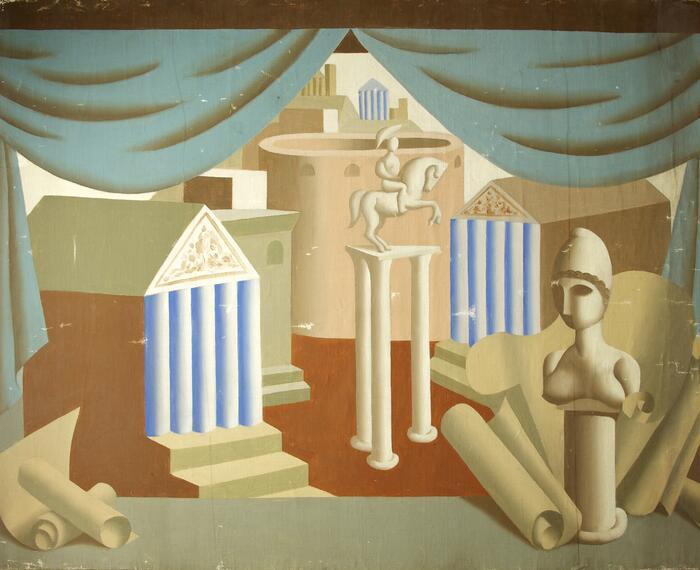


Installation view of ‘Hysterical Mining’ at Kunsthalle Wien, 29 May - 6 October 2019. All images are by Jorit Aust
Travelling directly from one of the Art World’s most important events – the Venice Biennale – one might expect a step down in gear on arrival in Vienna. We were in town with a group of our Museum Member curators to see how established art historical museums work with contemporary artists and get a flavour of the local artistic scene.
It just goes to show one should never have preconceptions. There is a thriving contemporary art scene here, bolstered by the city’s famous art academies, not-for-profit spaces, commercial galleries and world class museums. Vienna has the world’s oldest institution dedicated to contemporary art, Secession, which was founded in 1897 by a group of artists led by Gustav Klimt. When we visited, Peter Doig had a magnificent show in the main space, which Caroline wrote about so well a few weeks ago, and a site-specific installation by American artist Martine Syms called Boon that refers to a record shop in Detroit that recently closed down. Like her film A Pilot For A Show About Nowhere that we bought for Leeds Art Gallery two years ago, Boon also examines representations of blackness and gender.
Kunsthalle Wien is the other major institution in the city dedicated purely to contemporary art. The museum’s Director of Dramaturgy, Vanessa Joan Müller guided us through the exhibition Hysterical Mining, in which Austrian and International artists draw on radical techno-feminist theories from the 1970s until now, exploring technology’s role in shaping local and global configurations of power, forms of identity, and ways of living together. The exhibition crucially reveals how technology is still firmly coded as male, and how important the role of art is in deconstructing this notion.
On the upper floor Peter Friedl’s solo-exhibition Teatro focuses on a series of themes, such as language, history, translation and theatricality. The centre piece of the exhibition is the film Report (2016), which some of you might have seen when it was first presented at documenta 14 in Kassel two years ago.
Passing Vienna’s impressive Opera House at the Karlsplatz, our next stop was Galerie Krinzinger, founded in 1971 by art historian Dr. Ursula Krinzinger. This space is one of the most established galleries in Vienna and also includes an artist-in-residency programme in a separate building. We saw solo presentations by Mark Wallinger, William Mackrell and Radhika Khimji, all looking very impressive in a gallery setting that is housed in a former officer’s casino.
Before we finished our first day in Vienna with a well-deserved Wiener Schnitzel and Czech beer in the legendary restaurant Nordpol 3, artist Michael Zinganel toured our group through Vienna’s Northwest Railway Station. Here the artist explores the cultural and economic historical and contemporary significance of this last inner-city logistics hub in Vienna through research based exhibitions, theatre plays and open-air screenings. Historically this train station linked Vienna into colonial systems of trade and migration, despite not having its own overseas empire. Today it has been partially abandoned, making it an ideal site for artists to commandeer.
The next day was dedicated to tackling Vienna’s eternal dilemma: what is more impressive – the art on display or the magnificent Baroque architecture of the museums that house it?
With its superb gardens, Prince Eugene of Savoy’s former residence Schloss Belvedere is a stunning Baroque landmark and a UNESCO World Heritage Site. Here, the Upper Belvedere houses the world’s largest collection of Gustav Klimt’s paintings. Their Chief Curator, Harald Krejci, talked us through the recent re-hang of the collection, which for the first time includes contemporary art interventions by artists including Erwin Wurm, Ines Doujak and Christian Philipp Mueller. Krejci is also responsible for Belvedere 21, which only hosts contemporary art exhibitions in a landmark modernist building outside the Schlosspark. Moving through a large solo exhibition by Austrian painter Christian Ludwig Attersee, Caroline Achaintre is presenting new work in the lower level exhibition space.
Other highlights included studio visits with Martin Walde, Oliver Ressler, Gelitin and Eva Schlegel, which gave a good overview of some of the more established Viennese artists.
On our last day in Vienna we visited Kunsthistorisches Museum Vienna to see a display of paintings by American artist Mark Rothko, spanning from the early figurative works of the 1930s to the abstract paintings of the 1950s and 1960s that made him famous. We met with Chief Curator and art historian Jasper Sharp, who since joining the Kunsthistorisches Museum in 2011 has transformed the museum’s approach to modern and contemporary art. His programme encompasses major monographic exhibitions and invitations to artists such as Edmund de Waal to work with the historical collection. In his view, this adds a fresh perspective onto their collection and introduces contemporary art to new audiences.
These are just highlights, but still far too short a time to do the city’s art scene justice. We’ll be acquiring work this year for a number of our Museum Members represented on this trip, so we’ll certainly be back for more.
Christine Takengny
Curator